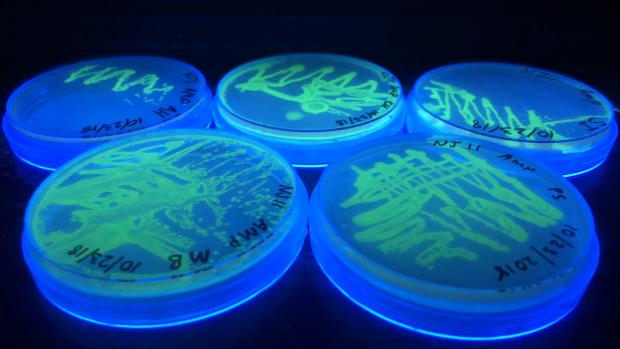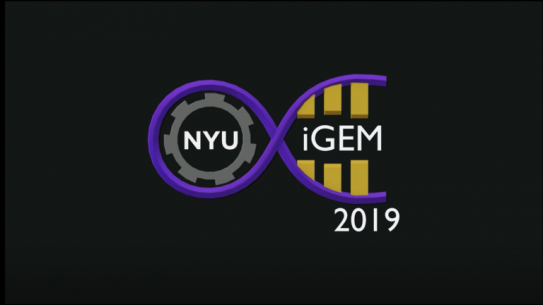Making Medicine Greener
A Team of Tandon Students Takes on the Pharmaceutical Industry

A sample of NYU iGEM's bacteria fluorescing in the lab
To literary fans with active imaginations, the International Genetically Engineered Machine (iGEM) Foundation may sound like an evil organization from some futuristic novel, but members of Tandon’s iGEM team, who are gearing up to take part in the group’s eagerly anticipated annual competition, would beg to differ.
The team, working under the auspices of Tandon’s Vertically Integrated Projects (VIP) initiative — which allows students to participate in multi-year, multi-disciplinary projects — is currently working to “cut and paste” DNA from plants into bacteria, in effect, turning the bacteria into small factories capable of producing antioxidants and pharmaceuticals.
Their project is focused on molecules called flavonoids, phytonutrients with anti-inflammatory properties and benefits for the immune system. Its aim is to create pharmaceuticals in a more sustainable and cost-efficient way than traditional methods, which produce millions of pounds of harmful waste each year. Their current work involves producing naringenin, the main flavonoid in grapefruit, which medical researchers believe has potential for the treatment of Alzheimer's disease, among other conditions.
The iGEM competition, held each fall, encourages students to ask new questions about what synthetic biology can do; imagine a future that uses biology as a design medium, and that relies on open-source, standardized parts to build novel biological functions; and consider their projects in a social and environmental context.
“We realize the phrase genetic engineering has negative connotations for many people,” team member Steven Ionov explains. “But since the late 1970s, scientists have been making synthetic human insulin from genetically modified yeast or bacteria cells. Before then, insulin was derived from the pancreases of animals, but the synthetic human version is more effective and causes fewer allergic reactions. Those scientists have saved countless lives, and that’s been an inspiration to us in our own work.”

Learn more about NYU iGEM
More Vertically Integrated Projects
seeking to make the world a healthier place...
3D-Printed Biomedical Devices
Orthotic devices can help those with cerebral palsy (CP) and other movement disorders tackle everyday activities and gain independence, but custom orthotics are often clunky, expensive, and — in the case of children — quickly outgrown. Team members have designed and prototyped low-cost, highly adaptable, 3D-printed devices for young patients using precise measurements taken by a mobile app. (And as an added bonus, the devices can be manufactured in eye-popping and appealing colors.)
NYU-X Holodeck
Under the auspices of the NYU Rory Meyers College of Nursing, team members investigate the use of emerging technologies for innovation in health care; examine how novel human-computer interaction, virtual and augmented reality, and next-generation fabrication solutions can be found for challenging problems in clinical care, medical education, and public health.
Wearable Technology
If you’ve ever worn a Fitbit or other fitness tracker, you know the value of having ready access to the data it collects. With physicians now using wearable devices to measure everything from breathing patterns to blood glucose, data from wearables is revolutionizing patient care and medical research. Led by MakerSpace founding director Victoria Bill, team members are delving into the design and production of conductive materials — and wearable sensors and antennas made from them.




